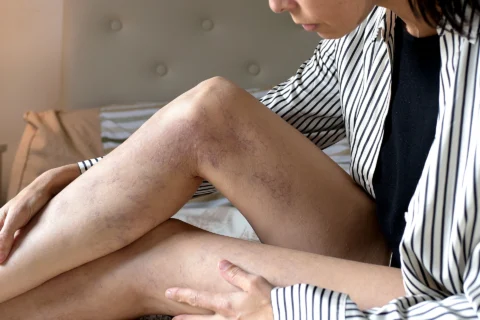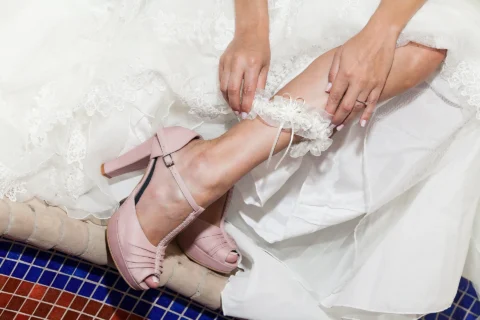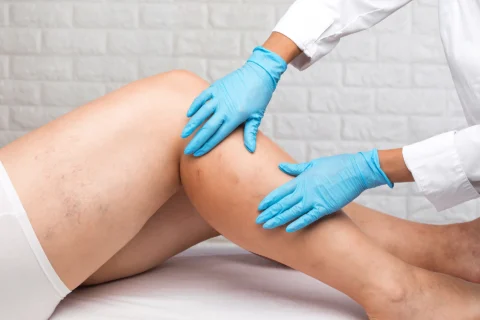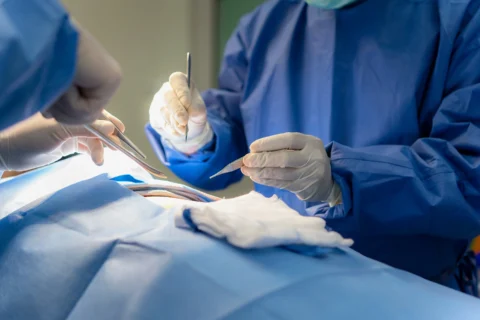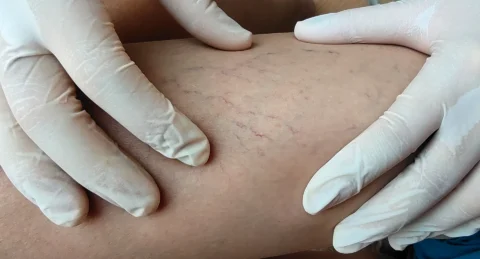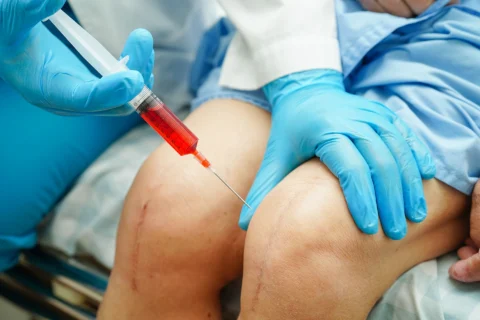Varicose vein condition is a common venous disease, which is a direct result of blood pooling and enlarged vein due to a weak vein wall or damaged valves. There are many factors that may have caused this condition to occur, and one of which is the pattern of your physical movement. Standing for a long period of time is one of the reasons why varicose veins flare up.
So why does standing cause varicose veins to flare up? Long periods of standing hamper regular blood circulation and puts increased pressure on your legs, which may cause or worsen varicose veins. Likewise, prolonged sitting also has a similar effect so don’t just stay in one place, keep yourself moving.
Why Standing Causes Varicose Veins and What to Do When They Are Flared?
Veins pump blood back to the heart through one-way valves. Over time, these valves can become weak or damaged. Weak valves cause blood to flow backward and pool in the vein, which causes swelling and enlargement, thus causing varicose veins.
Standing for a long period of time is one of the many causes why varicose veins flare up because of the disruption in blood circulation as well as the increased pressure in the legs to carry the upper part of the body. This is also the reason why people who have obesity are at greater risk of having varicose veins.
In contrast with spider veins, varicose veins are more than just a cosmetic problem that needs to be covered up or removed because they are unsightly. This venous disease may lead to medical conditions if it’s not treated immediately.
At the first sight of varicose veins, consult with a healthcare provider as soon as possible. Aside from prolonged standing or sitting, there may be underlying conditions associated with the varicose veins that flared up in your leg.
Thankfully, surgery isn’t the only hope for removing varicose veins. If you want varicose vein treatments that are virtually painless and effective, there are many non-invasive options that you can choose from to effectively remove these unsightly veins.
Other Causes of Varicose Veins
Aside from prolonged standing, there are many other causes of varicose veins. Among these causes, genetics is the most prevalent, with almost half of the varicose vein patients having a family history of varicose veins. Additionally, there’s also a 90% possibility that you’ll develop varicose veins if both of your parents had it. Other causes of varicose veins are:
- Aging
- Obesity or excessive weight gain
- Hormone fluctuations
- Increased pressure, trauma, or injuries around the affected vein
- Unhealthy lifestyle habits
Diagnosis of Varicose Veins
Varicose veins usually appear underneath the skin in the face, lower legs, arms, pelvic area, and sometimes even in the testicles. These appear on the surface of the skin as unsightly veins that branch out. These branches may be colored blue or purple with red outlines. There are instances when varicose veins are accompanied by bleeding, venous ulcer, and blood clot symptoms.
The appearance of varicose veins symptoms are enough to self-diagnose this condition. However, consulting with a healthcare provider, particularly a professional vein specialist, is important to rule out any underlying condition or the risk of having a serious medical disease. Among the underlying health conditions that may be causing your varicose veins are leg infection, open sores, and blood clots.
Ultrasound or physical examination is usually conducted to check the veins for possible complications or risks that may be associated with your varicose veins. Along with an interview, a physical examination can also help the vein specialist identify what causes your varicose veins. The cause of the varicose veins is important to help your healthcare provider create a more holistic treatment plan that includes lifestyle changes.
What Happens If Varicose Veins Aren’t Treated
Although there’s a possibility that the cause of varicose veins is largely unknown, this venous disease is still more than just a cosmetic condition. Even if it has been ruled out that your varicose veins aren’t a result of an underlying medical condition, it can still lead to serious health issues if left untreated such as the following:
- Chronic venous insufficiency (CVI). When varicose veins aren’t treated and they appear to become severe, chronic venous insufficiency may be a possible health condition that caused it. This condition affects the vein’s pumping capacity so it’s important to rule out the risk of chronic venous insufficiency by having your varicose veins treated by a qualified vein specialist.
- Thrombophlebitis. When varicose veins remain untreated, blood clots form inside the varicose veins, resulting in thrombophlebitis. This isn’t usually dangerous and it can be treated, however, this can be painful so you might want to address your varicose veins before these blood clots occur.
- Deep vein thrombosis. This condition is similar to thrombophlebitis, although it doesn’t occur in superficial veins. This means that deep vein thrombosis doesn’t just occur on already existing varicose veins, it also occurs in deep veins inside the body.
- Pulmonary embolism. One of the ways that deep vein thrombosis may worsen is through pulmonary embolism, which is a complication of the former condition. Pulmonary embolism is a life-threatening condition so it requires immediate medical attention upon its diagnosis.
How to Avoid Feeling Hopeless With Varicose Veins

Varicose veins is a venous disease that is unpleasant to look at once they flare out. This condition causes veins to appear as enlarged, overfilled, and twisted veins in the surface of the skin. This may also be both painful and unsightly at the same time.
Thankfully, you don’t have to feel hopeless when it comes to finding the right treatment for your varicose veins. Treating this venous disease can help avoid conditions such as skin ulcers and can reduce any sensation of pain. With several treatment options to choose from, you can have your varicose veins properly treated in no time.
Non-Invasive Treatment Options at Vein Center Doctor
Surgical and non-surgical treatments are available for varicose veins. We at the Vein Center Doctor offer a wide range of effective but minimally invasive varicose vein treatment options that do not require you to undergo invasive surgery like vascular surgery or varicose vein removal.
Check yourself and get the right varicose veins treatment option to avoid further complications from untreated varicose veins. Once you consult with a vein specialist, the following non-invasive treatment options may be recommended for you:
- Compression therapy
- Sclerotherapy
- Radiofrequency ablation
- Endovenous thermal ablation
- VenaSeal
1) Compression Therapy
Compression therapy is a simple treatment option that can be performed in the comfort of your own home. The goal of this non-invasive method is to create scar tissue that can heal faster than a damaged vein by closing it up and forming a suture. Compression stockings, compression bandages, and compression socks can speed up the varicose vein treatment process.
Aside from using pneumatic compression devices, the Vein Center Doctor uses state-of-the-art equipment for compression therapy. Your veins will be compressed by these compression devices and you will feel less pain and discomfort as a result. Aside from stopping your veins from further stretching, the compression also improves blood flow and eliminates varicose vein symptoms.
2) Sclerotherapy
Sclerotherapy involves injecting a salt solution directly into affected veins via an intravenous procedure. This is a popular treatment for varicose veins and spider veins. By injecting salt solution into the blood vessel lining, the blood vessel will be irritated, causing it to close and redirect blood to healthy veins. The closed vein is then reabsorbed by the body once it turns into scar tissue.
3) Radiofrequency Ablation
The treatment of varicose veins by radiofrequency ablation is one of the minimally invasive methods available. In order to treat the affected vein, radiofrequency technology uses heat energy to target them. As a result of radiofrequency treatment, the affected vein will eventually become damaged and scar tissue will form, closing it up and redirecting blood to healthier vessels.
4) Endovenous Laser Treatment
Varicose veins can also be treated with laser treatment, another minimally invasive procedure. In endovenous laser ablation, a laser fiber is guided by ultrasound to get the best results. This treatment is performed by specialists in interventional radiology. With laser fibers like these, damaged veins can be closed with heat while blood is safely redirected to vessels that are unharmed.
5) VenaSeal
VenaSeal is a “vein glue” that acts as an adhesive. This FDA-approved treatment option is injected into the affected vein to close up the damaged blood vessels. Doing this will allow the vein to form scar tissue, and redirect blood to healthier blood vessels.
Alternative Treatment Options for Varicose Veins
There are many treatment options for varicose veins, depending on the goal. Non-invasive treatment options may still be safer and more effective, but sometimes those options aren’t compatible with you. There are also instances when the mentioned treatment options are considered too much, even if these are non-invasive.
1) At-Home Therapy
Aside from compression therapy, there are also other simple therapy options that you can do at the comfort of your own home. The goal of this therapy is to improve blood flow in the leg vein through a series of routines established. Some routines include the following:
- Leg elevation. Reduce the pressure in your leg veins by elevating the legs above the level of your heart. A medicated wrap (i.e, Unna boot) may also be recommended to be used to facilitate this procedure at home.
- Simple exercises. Standing or sitting for long periods of time is one of the causes of varicose veins. Keep yourself moving with exercises that are as basic as walking.
- Healthy weight. Maintain a healthy weight, as well as normal blood pressure, through good lifestyle choices such as quitting smoking and decreasing food consumption. If you have excess weight, you can enlist the help of a healthcare provider to reduce body fat.
2) Medication
If your varicose veins aren’t caused by underlying conditions, a few lifestyle changes along with oral medication may help eliminate these unsightly veins. Some of the oral medications that may be prescribed by your healthcare provider are antibiotics and coagulants.
Unfortunately, medication merely cures the unpleasant appearance of varicose veins in the skin. So if your varicose veins are caused by an underlying condition, then this may not be a good option.
3) Varicose Vein Surgery
Varicose vein surgery is the last option considered by most providers. This is only applicable for severe varicose veins associated with any rare symptom that requires immediate medical assistance to avoid a more serious complication. Additionally, varicose vein surgery may also be recommended if there are no changes or significant improvements within 6 to 12 months after every option has been exhausted.
Prevention for Varicose Veins
There are many possible causes of varicose veins, so preventing them may be a difficult endeavor. Consequently, there is also a huge possibility that these unsightly veins may return even after treatment. Some possible ways that you can prevent varicose veins are the following:
- Increase physical movement and reduce long periods of sitting or standing
- Maintain a healthy lifestyle by quitting smoking and drinking
- Maintain a healthy weight through a healthy diet and regular exercise to reduce pressure to your blood vessels
- Don’t wear clothes that are too tight
Eliminate Flared Varicose Veins With Non-Invasive Treatment Options at Vein Center Doctor

Varicose veins are unsightly veins that may have many causes, including standing or sitting for a long period of time. So increasing physical movement is largely significant to reduce the pain from the affected vein and pressure in your legs. Additionally, increased movement helps regulate blood flow around the body. Along with lifestyle changes, the right treatment plan may also be recommended to you by a qualified vein specialist.
Vein Center Doctor is a reliable vein clinic that can resolve your vein problems. With an experienced team of vein specialists, Dr. Rahul Sood has conducted countless treatments such as varicose vein treatment, and even treatment for your reticular veins and spider veins. Schedule your appointment with our vein specialists at Vein Center Doctor today.


